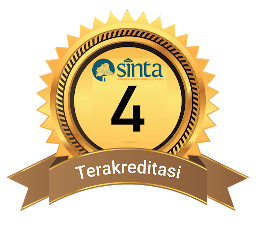The Relationship Between Learning Readiness And Achievement In Class XI Students of SMAN 1 Wawo
DOI:
10.29303/cep.v7i2.6186Published:
2024-12-04Issue:
Vol. 7 No. 2 (2024): Edisi NovemberKeywords:
learning readiness, learning achievementArticles
Downloads
How to Cite
Abstract
This research purpose is to analyze relation between learning readiness and chemistry learning achievement in class XI MIA SMAN 1 Wawo, academic year 2022/2023. This research is quantitative descriptive. The data collection method uses student learning readiness questionnaire and documentation to obtain data on student chemistry learning achievement. The data analysis method used is inferential statistical analysis. The data processing method with parametric statistics uses the Product Moment Correlation formula. Presentation of data in the form of a frequency distribution table and group explanations through the highest score, lowest score, mean, median, mode, and standard deviation. The result of this study indicates that there is a significant relation between student learning readiness and chemistry learning achievement in class XI MIA SMAN 1 Wawo in the 2022/2023 academic year. This is shown by rcount (0.878) > rtable (0.254) and tcount (13.971) > ttable (2.021) at an error level of 5% and the contribution of learning readiness of 77.08% to learning achievement.
References
Afriyanto, F., & Hera, H. SS. (2019). Hubungan antara Keteladanan Guru BK dengan Perilaku Sopan Santun Siswa Kelas VIII D SMP Negeri 1 Colomadu Tahun Pelajaran 2018/2019. Jurnal Medi Kons, 5(2), 50-58.
Dalyono, M. (2012). Psikologi Pendidikan. Jakarta: Rineka Cipta.
Direktorat Pembinaan SMA. (2017). Panduan Penilaian Oleh Pendidik dan Satuan Pendidik Untuk SMA. Jakarta: Kementerian Pendidikan dan Kebudayaan.
Djamarah, S. B. (2011). Psikologi Belajar. Jakarta: Rineka Cipta.
Faizah, S. N. (2017). Hakikat belajar dan pembelajaran. At-Thullab: Jurnal Pendidikan Guru Madrasah Ibtidaiyah, 1(2), 175-185.
Hapudin, H. M. S. (2021). Teori belajar dan pembelajaran: menciptakan pembelajaran yang kreatif dan efektif. Prenada Media.
Hasibuan, A. S., Nelwati, S., & Mardison, S. (2020). Hubungan kesiapan dengan prestasi belajar peserta didik. Jurnal Al-Taujih: Bingkai Bimbingan dan Konseling Islami, 6(1), 37-43.
Hendryadi. (2017). Validitas Isi: Tahap Awal Pengembangan Kuesioner. Jurnal Riset Manajemen dan Bisnis (JRMB), 2(2), 169-178.
Mulyono, & Ampo, I. (2021). Pemanfaatan Media Dan Sumber Belajar Abad 21. Paedagogia: Jurnal Pendidikan, 9(2), 93–112.
Parwati, N. N., Suryawan, I. P. P., & Apsari, R. A. (2023). Belajar dan pembelajaran. PT. RajaGrafindo Persada-Rajawali Pers.
Retnawati, H. (2016). Analisis Kuantitatif Instrumen Penelitian. Yogyakarta: Parama Publishing.
Slameto. (2015). Belajar dan Faktor-faktor yang Mempengaruhinya. Jakarta: Rineka Cipta.
Sugiyono. (2019). Statistika untuk Penelitian. Bandung: Alfabeta.
Sugiyono. (2011). Metode Penelitian Kuantitatif Kualitatif dan R&D. Bandung: Alfabeta.
Sukmadinata. N. S. (2014). Landasan Psikologi Proses Pendidikan. Bandung: Remaja Rosdakarya.
Suryono, H., & Rejekiningsih, T. (2007). Uji Persyaratan Analisis Statistik. Inovasi Pendidikan, 8(2), 187-196.
Syafi’i, A., Marfiyanto, T., & Rodiyah, S.K. (2018). Studi Tentang restasi Belajar Siswa Dalam Berbagai Aspek dan Faktor Yang Mempengaruhi. Jurnal Komunikasi Pendidikan, 2(2), 119-120.
Usmadi. (2020). Pengujian Persyaratan Analisis (Uji Homogenitas dan Uji Normalitas). Inovasi Pendidikan, 7(1), 50-62.
Author Biographies
Muhammad Auliya Rahman, Universitas Mataram
Jeckson Siahaan, Program Studi Pendidikan Kimia, Universitas Mataram
Mukhtar Haris, Program Studi Pendidikan Kimia, Universitas Mataram
License
Copyright (c) 2024 Muhammad Auliya Rahman Rahman

This work is licensed under a Creative Commons Attribution-ShareAlike 4.0 International License.
Authors who publish with Chemistry Education Practice agree to the following terms:
- Authors retain copyright and grant the journal right of first publication with the work simultaneously licensed under a Creative Commons Attribution License 4.0 International License (CC-BY-SA License). This license allows authors to use all articles, data sets, graphics, and appendices in data mining applications, search engines, web sites, blogs, and other platforms by providing an appropriate reference. The journal allows the author(s) to hold the copyright without restrictions and will retain publishing rights without restrictions.
- Authors are able to enter into separate, additional contractual arrangements for the non-exclusive distribution of the journal's published version of the work (e.g., post it to an institutional repository or publish it in a book), with an acknowledgement of its initial publication in Chemistry Education Practice.
- Authors are permitted and encouraged to post their work online (e.g., in institutional repositories or on their website) prior to and during the submission process, as it can lead to productive exchanges, as well as earlier and greater citation of published work (See The Effect of Open Access).






